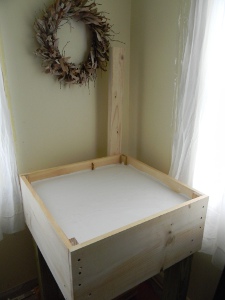It's almost like being called home. Not in the religious sense, but in that very real world way we find ourselves gravitating to what we know. I have been making my living as a paramedic and manager of
Peninsula Ambulance in Blue Hill. I have enjoyed that career and still find the work rewarding.
Given what I said about a career in medicine in the first part of my story, it's more than a little ironic as well.
But I was always happiest with mud on my hands. And regardless of any other choices I made or the reasons for them, I knew I wanted to return to pottery. People in emergency medical services don't make the sort of living that allows a leisurely retirement. For that matter, very few do. I began thinking about a retirement job that would suit me well and the idea of opening a pottery studio immediately came to mind. After all, if you are going to have to work for the rest of your life, you should be doing something you love.
One person I know refers to this as intentional living. I like the sound of that.
So in 2007, when I got a phone call asking if I would be willing to join in on a project to reformulate the glazes at Rowantrees, I reacted in a predictable manner. I was extremely reluctant.
Change. You dream about it and then get all crampy when it presents itself.
I gave it a lot of thought and picked up my phone. Yes, I would do the research and see if I could reformulate the glazes. I was nervous about that, but I had done a lot of work on this very project about 18 years before while working at Rowantrees. That gave me a good base to start from. And believe it or not, I had saved all my notes. Call it prophetic, but I was actually prepared.
To back up just a bit, I should point out that the original glazes used at Rowantrees were formulated with lead. They were very beautiful and unique glazes that stood up well. And I'll share another little tidbit with you; I always felt they were safe to use. To this day, I have many pieces of Rowantrees in my kitchen and I continue to use it.
But the problem with lead is more than its toxicity and the need to keep it food safe. Science on the issue has changed over the last couple of decades. What was once considered safe is not any longer. Changes in federal standards caused Rowantrees to issue a recall on their products a few years ago, but few if any customers decided to return their pottery.
You can't buy loyalty like that. It is earned over many years, and Rowantrees had earned it.
But laws are laws. And eventually, it became illegal to purchase lead. Even ceramic stains and commercial glazes containing lead disappeared. I guess we can call that progress, but a lot of beauty has vanished.
So the glazes needed to be reformulated and I stepped up to the plate.
The best replacement for lead is boron. It's non-toxic and not only helps a glaze to melt, but it also forms glass. It has it's own properties, limitations and advantages, but it is a radical change in the chemistry of a glaze. Copper, normally used to produce shades of green in a glaze, tends toward blue with boron. Surface textures that are glassy smooth with lead are far more difficult to achieve. Firing can take considerably longer with boronated glazes.
But if pottery is nothing else, it is a constant challenge. You are always solving a problem or puzzling out a poser of one sort or another. This keeps a brain active and young, I think.
The process was slow, and in the midst of it, I began to think seriously about taking over the Rowantrees business. I went as far as to talk with the bank and a counselor at the
Maine Small Business Development Center. While this particular idea never got off the ground, it gave me another.
But I'm getting ahead of myself. What about the glazes?
Well, most of them remain a work in progress. But not all of them. Two of the most popular colors are reformulated and almost indistinguishable from the original. These are the Heather Blue and White glazes. Here is a picture of a Rowantrees coffee cup and saucer glazed with the original lead glazes:

And here is the reformulated, lead-free version:

Of course, a lot can affect the exact color; thickness of application, amount of overlap, firing time, even the water used to make the glaze. But variations in color and size are the hallmark of hand crafted items. They show the hand at work behind the object and remind us not only of the endless variation in nature, but in ourselves. That is what keeps things new and vibrant.
I will post more pictures of the glaze project as the reformulations progress.
And soon, I will tell you why all of this matters!













